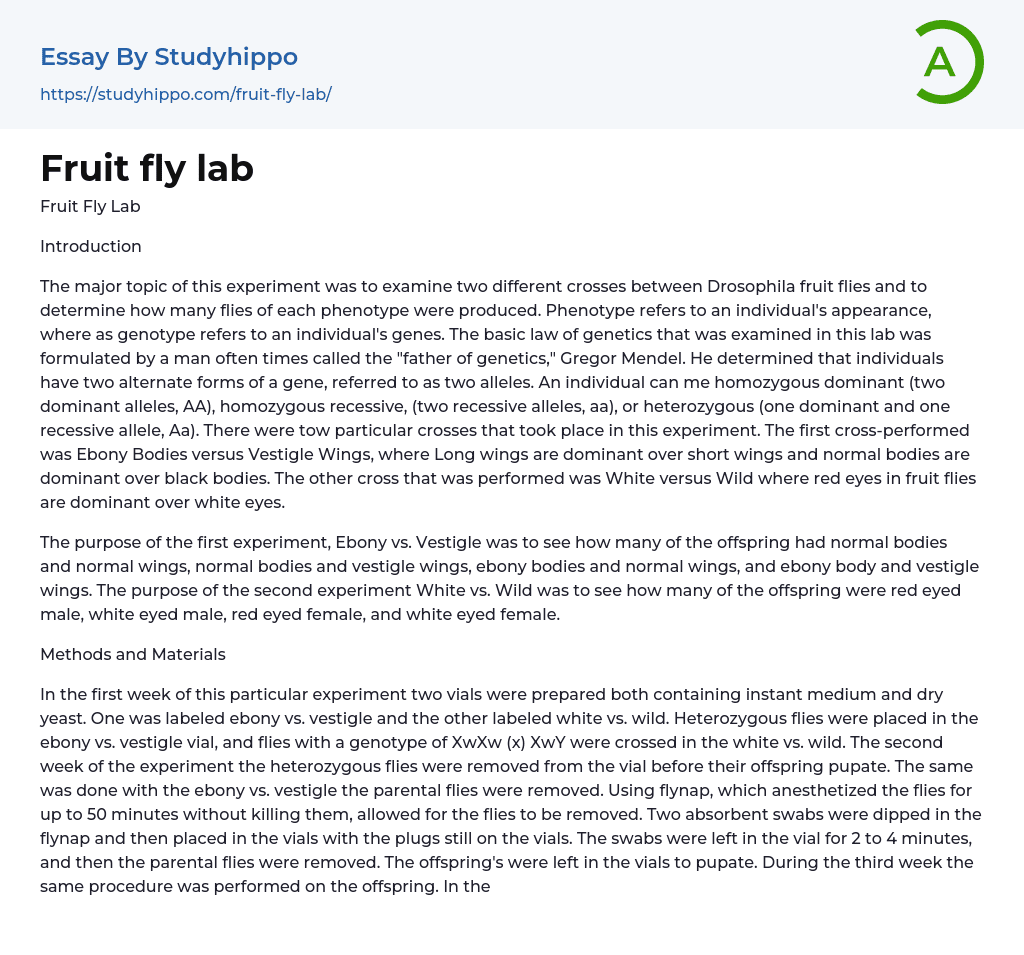vestigle and the other vial was labeled white vs. wild. Each vial contained 10 fruit flies, consisting of five males and five females. The flies were left to mate for a week in their respective vials.
In the second week, the offspring from each cross were counted and observed. The number of flies with each phenotype was recorded. This included normal bodies with normal wings, normal bodies with vestigle wings, ebony bodies with normal wings, ebony bodies with vestigle wings, red-eyed males, white-eyed males, red-eyed females, and white-eyed females.
The results from both crosses were analyzed to determine if they followed Mendel's principles of genetics. This involved comparing the observed numbers of each phenotype to the expected numbers based on Mendel's laws.
Overall, this experiment aimed to study genetics using Drosophila fruit flies an
...d determine the phenotypes present in the offspring of two specific crosses.wild contained flies with white eye color and a genotype of XwXw (x) XwY. In both vials, instant medium and dry yeast were present. Heterozygous flies were placed in the ebony vs. vestigle vial, while the white vs. wild vial housed the cross between flies with a genotype of XwXw (x) XwY.
In the second week, the heterozygous flies from both vials were removed before their offspring pupated using Flynap, an anesthetic that does not harm the flies. Two absorbent swabs dipped in Flynap were inserted into each vial with plugs still intact for 2 to 4 minutes to remove the parental flies. The offspring remained in the vials to pupate.
The same procedure was repeated during the third week on the offspring from both vials. In the ebony vs. vestigle vial, separation occurred based on
body color and wing type: normal bodies with normal wings, normal bodies with vestigle wings, ebony bodies with normal wings, and ebony bodies with vestigle wings.
In contrast, separation in the white vs. wild vial was based on eye color and gender: red-eyed males, white-eyed males, red-eyed females, and white-eyed females.
The parental cross in the white vs. wild vial resulted in white-eyed females (x) red-eyed males; however, there is no mention of phenotypes resulting from crosses conducted in the ebony vs.vestigle vial within this text passage.
wild had white-eyed males and red-eyed females.The F1 cross for ebony vs.vestigle had normal body and normal winged offspring.I expected a phenotypic ratio of 3:1 for white vs.wild, where most offspring would have the red-eyed dominant allele and some would have the white-eyed recessive allele.For ebony vs.wild, I expected all offspring to have ebony body color, with a 50% chance of normal wings and a 50% chance of vestigle wings.The results were as follows: [remaining results].
- Microbiology essays
- Bacteria essays
- Cell essays
- Enzyme essays
- Photosynthesis essays
- Plant essays
- Natural Selection essays
- Protein essays
- Viruses essays
- Cell Membrane essays
- Human essays
- Stem Cell essays
- Breeding essays
- Biotechnology essays
- Cystic Fibrosis essays
- Tree essays
- Seed essays
- Coronavirus essays
- Zika Virus essays
- Dna essays
- Gene essays
- Agriculture essays
- Albert einstein essays
- Animals essays
- Archaeology essays
- Bear essays
- Biology essays
- Birds essays
- Butterfly essays
- Cat essays
- Charles Darwin essays
- Chemistry essays
- Dinosaur essays
- Discovery essays
- Dolphin essays
- Elephant essays
- Eli Whitney essays
- Environmental Science essays
- Evolution essays
- Fish essays
- Genetics essays
- Horse essays
- Human Evolution essays
- Isaac Newton essays
- Journal essays
- Linguistics essays
- Lion essays
- Logic essays
- Mars essays
- Methodology essays




